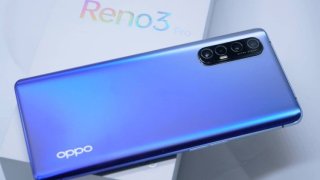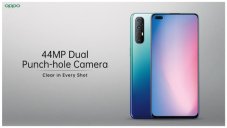Oppo Reno3 Pro
$369 | 32990
- 6.4" 1080x2400 pixels
- 64MP 2160p
- 8GB RAM Helio P95
- 4025mAh Li-Po
Phone Finder
- Acer alcatel Allview Amazon Amoi Apple Archos Asus AT&T Benefon BenQ BenQ-Siemens Bird BlackBerry Blackview BLU Bosch BQ Casio Cat Celkon Chea Coolpad Cubot Dell Doogee Emporia Energizer Ericsson Eten Fairphone Fujitsu Siemens Garmin-Asus Gigabyte Gionee Google Haier HMD Honor HP HTC Huawei i-mate i-mobile Icemobile Infinix Innostream iNQ Intex itel Jolla Karbonn Kyocera Lava LeEco Lenovo LG Maxon Maxwest Meizu Micromax Microsoft Mitac Mitsubishi Modu Motorola MWg NEC Neonode NIU Nokia Nothing Nvidia O2 OnePlus Oppo Orange Oscal Oukitel Palm Panasonic Pantech Parla Philips Plum Posh Prestigio QMobile Qtek Razer Realme Sagem Samsung Sendo Sewon Sharp Siemens Sonim Sony Sony Ericsson Spice T-Mobile TCL Tecno Tel.Me. Telit Thuraya Toshiba Ulefone Umidigi Unnecto Vertu verykool vivo VK Mobile Vodafone Wiko WND XCute Xiaomi XOLO Yezz Yota YU ZTE
Oppo Reno3 Pro Summary
Along with the rapid progress of technology, the boundary between the high-end and high-end flagship segments is becoming blurred than ever. The "finesse" features such as multi-lens camera clusters, bezel-less design, Super AMOLED screen that supports HDR or super-fast charging, once a dream, have now become much more accessible in the mid-range segment.
Oppo Reno3 Pro is one of the names I want to talk about. Officially launched in India in March, along with the vanilla Reno3, Reno3 Pro owns all these features, and most notably, the 44MP dual selfie camera setup.
Nice screen: very good brightness, with HDR
Reno3 Pro features a 6.4-inch Full HD + screen, Oppo's Sunlight Super AMOLED panel, which will help improve outdoor visibility. Personally, Reno3 Pro has a high-quality display with high brightness - Oppo said the device can reach a maximum brightness of up to 1200 nit - in the process of using almost I never have to set brightness over 80%.
Besides, the screen panel of Reno3 Pro also has up to 100% DCI-P3 color coverage, supports HDR so colors are very vivid and accurate, especially when watching content on Netflix and Youtube. It also does not have HDR display errors like Realme 6 Pro and Redmi Note 9s and the punch-hole is not annoying when viewed in full screen. In terms of display quality, I can say that Reno3 Pro is on par with today's flagship phones.
However, the Reno3 Pro's display does not have a high 90Hz refresh rate like the Chinese version, a trend that is increasingly popular. A high refresh rate offers smoother scrolling experiences, in exchange for a slight sacrifice of battery life.
Performance: Sufficient & Smooth
The Reno3 Pro is powered by Mediatek's Helio P95 chip, a slight upgrade version of the Helio P90 on the Reno3. In this price range, I would expect the Reno3 Pro to have a more powerful chip, the Snapdragon 765 as the Chinese domestic version is reasonable, but the Helio P95 also has its own advantage of very good battery life, which I will discuss in more depth later.
Testing with familiar titles through GameBench software, playing PUBG Mobile, Reno3 Pro was locked at 30fps with HD setting and 40fps with a high-graphics setting. Prioritizing fps, I tested at a low-graphics setting and the Reno3 Pro reached an average of 40 fps, with no frame drop in fire or gun scenes.
COD Mobile is a very popular game today, and I decided to experiment with Reno3 Pro. The game automatically sets the average graphics level, and Reno3 Pro maintains at 60 fps for most of the playing time, except in the lobby and when downloading the map, the game limits itself to 30 fps to save battery.
During actual use, I didn't complain much about the performance of Reno3 Pro, partly because my needs were not too high. Surfing the web, watching movies, playing PUBG Mobile, the Reno3 Pro’s Helio P95 is sufficient, and 8GB of RAM is enough for multitasking.
Battery is beefier than expected and supports 30W fast charging
Equipped with a 4,025 mAh battery, I did not expect much from the Reno3 Pro at first, as 5,000 mAh is gradually becoming the new standard. However, retaining the advantage of the previous Reno, Reno3 Pro with Helio P95 chip delivers a very good battery, both in our battery test and practical use. Compared to Reno2, the battery life when playing games and surfing the web of Reno3 Pro are significantly improved.
The battery life of Reno3 Pro is enough to last a working day, with Wi-Fi, 4G, and Bluetooth always on. By the end of the day, I still had about 20-25% of the battery. Charging time is also not a problem with Reno3 Pro when the device supports 30W VOOC 4.0 fast-charging capacity. According to my measurements, 20 minutes of charging gets it to 50% and it takes 52 minutes to reach a full 100%.
The camera is the highlight of the phone
Camera quality has always been something Oppo has been praised for, especially selfie cameras, and the Reno3 Pro did not disappoint me. In terms of hardware, Reno3 Pro features a total of 6 cameras, 4 at the back, and 2 on the front. The rear camera cluster includes a 64MP main camera, the ISOCELL GW01 sensor we have seen on Realme 6 Pro or Samsung Galaxy M31, along with a 13MP telephoto camera with 2X optical zoom, 8MP wide-angle camera, and a 2MP black-and-white and depth sensor. Meanwhile, the front camera cluster is in the punched section including the 44MP main camera and 2MP secondary camera that supports portrait mode. In low light, Reno3 Pro still produces good photos and bright colors. It has Night Mode and Ultra Dark Mode - this mode will automatically activate when it detects that there is too little light in the scene.
Reno3 Pro has a lot of options when you are photographing distant subjects. Besides 64MP mode, Oppo also integrated the "upscale" software to produce 108MP photos - only in professional mode - then you can crop the area you want. With a closer subject, 2X optical zoom, 5X hybrid zoom, or 20X digital zoom may be a more reasonable choice.
While other brands are competing on the resolution race on the main camera, Oppo has started a new competition with the 44MP selfie camera on the Reno3 Pro. After spending some time on it, this camera setup has shown that the high resolution is not only for show off but it also offers high quality in almost every aspect from color, detail, white balance.
Oppo Reno3 Pro Full Specifications
- Dollas $369 Buy in Flipkart >
- Rupee ₹32990 Buy in Flipkart >
- Technology GSM / HSPA / LTE
- 2G bands GSM 850 / 900 / 1800 / 1900 - SIM 1 & SIM 2
- 3G bands HSDPA 850 / 900 / 2100
- 4G bands 1, 3, 5, 8, 38, 40, 41
- Speed HSPA 42.2/5.76 Mbps, LTE-A
- Announced 2020, March 2
- Status Available. Released 2020, March 6
- Dimensions 158.8 x 73.4 x 8.1 mm (6.25 x 2.89 x 0.32 in)
- Weight 175 g (6.17 oz)
- Build Glass front (Gorilla Glass 5), plastic back, plastic frame
- SIM Dual SIM (Nano-SIM, dual stand-by)
- Type Super AMOLED capacitive touchscreen, 16M colors
- Size 6.4 inches, 101.8 cm2 (~87.4% screen-to-body ratio)
- Resolution 1080 x 2400 pixels, 20:9 ratio (~405 ppi density)
- Protection Corning Gorilla Glass 5
- 500 nits typ. brightness (advertised) 800 nits max brightness (advertised)
- OS Android 10.0; ColorOS 7
- Chipset Mediatek Helio P95 (12 nm)
- CPU Octa-core (2x2.2 GHz Cortex-A75 & 6x2.0 GHz Cortex-A55)
- GPU PowerVR GM9446
- Card slot microSDXC (dedicated slot)
- Internal 128GB 8GB RAM, 256GB 8GB RAM
- UFS 2.1
- Modules 64 MP, f/1.7, 27mm (wide), 1/1.72", 0.8µm, PDAF 13 MP, f/2.4, 52mm (telephoto), 1/3.4", 1.0µm, PDAF, 2x optical zoom 8 MP, f/2.2, 13mm (ultrawide), 1/4.0", 1.12µm, AF 2 MP B/W, f/2.4, (depth)
- Features Dual-LED flash, HDR, panorama
- Video 2160p@30fps, 1080p@30fps; gyro-EIS
- Modules 44 MP, f/2.4, 26mm (wide), 1/2.65", 0.7µm 2 MP, f/2.4, (depth)
- Features HDR
- Video 1080p@30fps
- Loudspeaker Yes
- 3.5mm jack Yes
- WLAN Wi-Fi 802.11 a/b/g/n/ac, dual-band, Wi-Fi Direct, hotspot
- Bluetooth 5.0, A2DP, LE
- GPS Yes, with A-GPS, GLONASS, GALILEO, BDS
- USB Type-C 1.0 reversible connector, USB On-The-Go
- Sensors Fingerprint (under display, optical), accelerometer, gyro, proximity, compass
- Non-removable Li-Po 4025 mAh battery
- Charging Fast charging 30W, 50% in 20 min (advertised) VOOC 4.0
- Colors Auroral Blue, Midnight Black, Sky White
- Models CPH2035
- SAR 1.18 W/kg (head) 1.07 W/kg (body)
- Performance AnTuTu: 165224 (v7), 227810 (v8) GeekBench: 7028 (v4.4), 1517 (v5.1) GFXBench: 7.4fps (ES 3.1 onscreen)
- Display Contrast ratio: Infinite (nominal)
- Camera Photo
- Loudspeaker -27.4 LUFS (Good)
- Battery life Endurance rating 104h
Oppo Reno3 Pro News

Mobile - Mar 02, 2020
OPPO Reno 3 Pro Unveiled In India As World's First Phone With 44MP Dual Selfie...

Mobile - Feb 28, 2020
You Can Now Pre-Order OPPO Reno 3 Pro In India & Get Attractive Offer

Mobile - Feb 23, 2020
OPPO Reno 3 Pro Pre-Order In India Starts Now; Official Launch On 2 March

Mobile - Feb 18, 2020
OPPO Reno 3 Pro Dummy Units Show Official Design & Key Specs

Mobile - Feb 14, 2020











